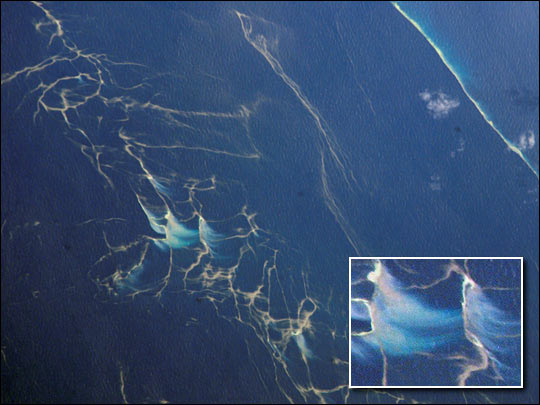


Detailed imagery taken by astronauts from the International Space Station (ISS) provides a new way of looking at many features on the Earth’s surface. This image captures a plankton bloom in the Capricorn Channel off the Queensland coast of Australia. The whispy pattern of the bloom suggests that the plankton are Trichodesmium—a photosynthetic cyanobacteria, also called “sea saw dust” that is common in the world’s oceans. Trichodesmium is frequently observed around Australia this time of year. In fact, Captain Cook’s ship logs written while he was sailing in Australian waters in the 1700s contain detailed descriptions of Trichodesmium blooms. Trichodesmium species are particularly important because of their role as primary producers: by sheer abundance, they fix a large amount of CO2 and N2.
Astronauts frequently photograph large plankton blooms during their missions because a significant portion of the ISS orbits cross long stretches of ocean. In the process, astronauts become acute observers of subtle changes in sea surface dynamics. Imagery of surface plankton blooms are multi-dimensional (in space and time) visualizations for the unique physical and chemical circumstances that support the blooms. Astronauts are trained and encouraged to document phytoplankton blooms, and to make repeated observations to better understand the longevity and temporal variations of the blooms. Only recently have astronauts had the capability of documenting these ocean features at high resolution—we estimate that each pixel in this image represents a square with sides of 6-8 m. The inset box shows zooms in on part of the bloom to illustrate the level of detail available.
For more information, read the article about Trichodesmium from the Woods Hole Oceanographic Institute.
Astronaut photograph ISS005-E-21572 was taken December 3, 2002, and is provided by the Earth Sciences and Image Analysis Laboratory at Johnson Space Center. Additional images taken by astronauts and cosmonauts can be viewed at the NASA-JSC Gateway to Astronaut Photography of Earth.